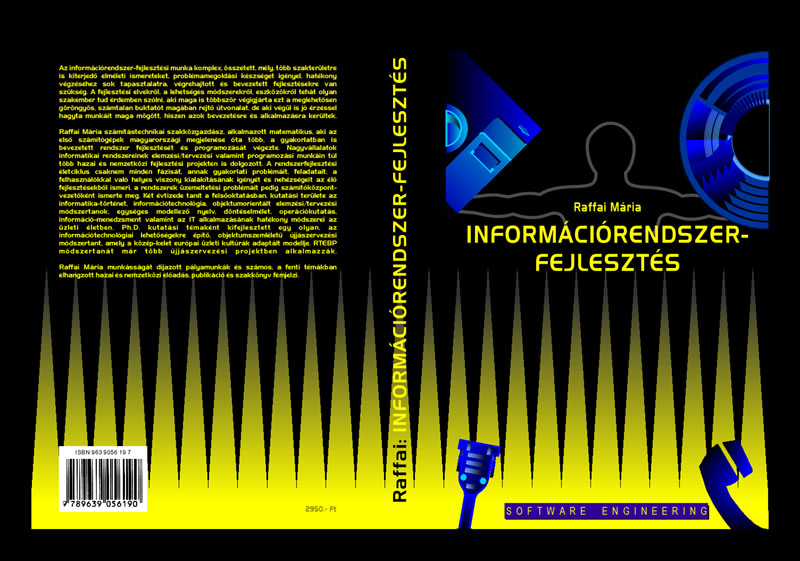|
This book is prepared first of all for the students, who would like to became
an expert in the field of information technology,
system engineering and computer science,
and who are willing to be a good engineer (system analyst and designer
in this context), but this book is proposed for the specialists in practice
as well. The author dicusses all of the important questions about the information
systems, the IT possibilities, and she gives a very good summary of the
main tasks, techniques and tools nessesary in the hole IE life cycle. The
book is the only up-to-date one in Hungarian language, which deals not
only with the different paradigm, methods, techniques and tools of IE,
but describes some development methodologies showing patterns as well.
Some very practical books belong to this volume: IRT2,
IRT3,
IRT4, Decision-Making,
in which the Readers can find the right way of the engineering work with
very good examples and case studies.
The brief content is as follows:
-
Information, system,
information system:Data, information, knowledge; System and
organisation;. Business processes; Business environment; Information and
information system
-
The Information
Revolution: Globalisation; Information Technology (new era of
the IT, popularisation, on-line business, E-Business); The creation
of the Information Society (responsibilities, tasks, programs)
-
Information management:
The changed role of IT; information-resource as a strategic factor; The
new form of organizations, Cybercorp; Business goals, vision and information
strategy; The tasks of the information-management,
-
Information Engineering:
The engineering technology ( the production of software, the
process of engineering); Engineering paradigm; The importance of the methodology
{methods (conventional, OO) and tools}; The role of visualisation (focusing
on tools, diagrams, standards and UML)
-
Project-management:
Requirements specification; Software Quality and the aim and models of
SQA; Starting a development project; Project-management (scheduling, methods);
Risk- and change management
-
The analysis phase:.
The role of the system-diagnosys; The organisation architecture (units,
tasks, roles, responsibilities); The business processes (definition, classification);
data-flow analysis; System behaviour; requrements specification; the "is"
model
-
Information system
design: Abstraction, hashing, modelling; System design by conventional
philosophy (data-model, normal forms, functionality); Object-Oriented design
(object modelling, behaviour, functional view, roles, interfaces);. Migration
from structured to OO
-
The system from
the physical point of view: The logical and physical models,
the classification of the components; Design of computer configuration
(requirements, tasks, factors); Data-base design (historical overview,
database and -management, database systems); Data Base Management System,
special applications (data-mining, data-warehouse); Human-machine communication:
the human factor of the computer-based systems, the communication model,
design of input/output and dialogues
-
Implementation
phase: Software design: Design philosophies, Implementation
(strategies, steps, environment), Component-specification, Peogram-documentation;
Testing (strategies, techniques and tools; validation, verification, testing
levels): test-plan, test-data, evaluation
-
Software maintenance:.
Deliver the IS into operation (new organization architecture, roles, responsibilities,
education, training, skills); System-efficiency, Measures and factors;
Maintenance tasks
-
The software as
an automation tool of the development: Philosophy of development
automation; Integrated development tools; 4GL, 5GL software; CASE tools;
Unified Modelling Language
-
Looking forward
Appendix:
-
The process flow of the IE
-
Object-Oriented System Development - Case
Study
-
Conventional Methodologies: SADT, DSSD,
ISAC, SDM, SSADM, DARTS , Domino
-
Object-Oriented Mathods: Lorensen’s method,
OMT (Rumbaugh), OOADA (Booch), Fusion, OOSE (Jacobson), OOIE (Martin-Odell),
OOA/D(Coad/Yourdon), Shlaer/Mellor method
-
EuroMethod
-
UML - Unified Modeling Language
Order: Foundation ALEXANDER
H-9026 Gyõr, Hédervári út 49/a (96-311-118);
foundation.alexander@gmail.com
 Home
Home  Publications,
Proceedings
Publications,
Proceedings
|
